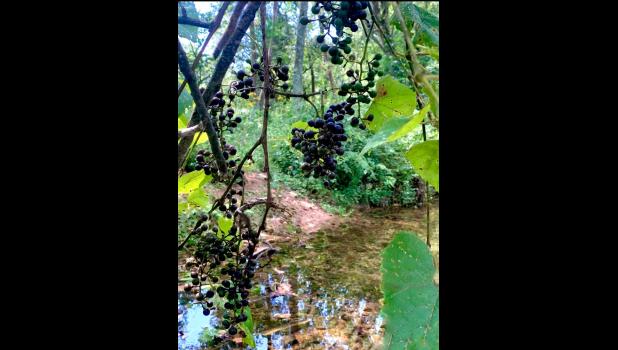MISSOURI GIRL EATS WEEDS
Wed, 09/09/2020 - 1:36pm
admin
Wild Grapes
By:
Ann J. Hines, PhD
If you’ve lived in Missouri more than five minutes, I’m sure you already know something about our wild grapes: tiny, seedy, and often hard to reach. That’s if the wildlife don’t beat you to them! Despite these challenges, they remain one of the favorite wild edibles in our state. Their deeply pigmented skins are full of flavor and nutrition, and they create coveted juice and jellies.
If you’re new to the area, there are a few look-alikes in the grape family to avoid. The Virginia Creeper, or woodbine, looks like poison ivy but has five leaves instead of three, and produces clusters of dark berries. Pepper vine and raccoon grape both have multi-colored berry clusters that are beautiful in bouquets but not suitable for eating. While the berries of these two look alike, they have very different foliage: the pepper vine has compound leaves, while the raccoon grape has a larger heart-shaped leaf. Common Moonseed is another vine with grape-like clusters, but as its name suggests, the seeds are crescent shaped. Poke, previously discussed in this column, produces dark purple clusters of berries, but it’s easy to distinguish from grape because it is not a vine.
While cultivated grapes have been hybridized to increase sugar and water content, the wild varieties are even more nutritious. The skins and seeds have the richest concentration of nutrients, including B vitamins, vitamin C, manganese and potassium. The skins of wild grapes are deeply pigmented with anthocyanidins, a potent category of antioxidants that give fruits and flowers their blue, red and purple colors. We’ve all heard the benefits of red wine being touted, and this is due to the resveratrol content, which is enhanced by the fermentation process. It is another beneficial bioflavonoid found in the skins and seeds of the grapes that is widely studied for its impressive anti-aging abilities. It decreases heart disease with its anti-inflammatory properties and protection against atherosclerosis (thickening of the arteries) and ability to lower “bad cholesterol.” For the brain, it has neuroprotective effects, including protection against Alzheimer’s and other dementias. Resveratrol and other phenolics also inhibit the growth and spread of cancer. As a phytoestrogen, resveratrol is being studied for its beneficial role in post-menopausal women and for breast cancer.
Since I’ve said so much about resveratrol, let me mention another excellent source you can find in our Missouri woods: Japanese knotweed. This plant is highly invasive, so eat it to limit its spread and for the nutritional benefits.
While most recipes call for juicing the grapes by cooking them and mashing the pulp, in recent years my Aunt Christie discovered a simpler method: She puts one heaping cup of grapes, half a cup of sugar or equivalent of sweetener (my mother uses stevia, a non-caloric sweetener that holds up in the canning process) in a quart jar and covers with room temperature distilled water. (You can use tap water, but she likes the flavor better with distilled.) Then she puts them in a hot water bath for 20 minutes. Let them set for at least a month for best flavor. When you serve them, just strain the juice. I have fond memories of drinking wild grape juice punch at Thanksgiving and Christmas at my grandmother’s.
Mix equal parts juice and sparkling water and serve in a punch bowl.


